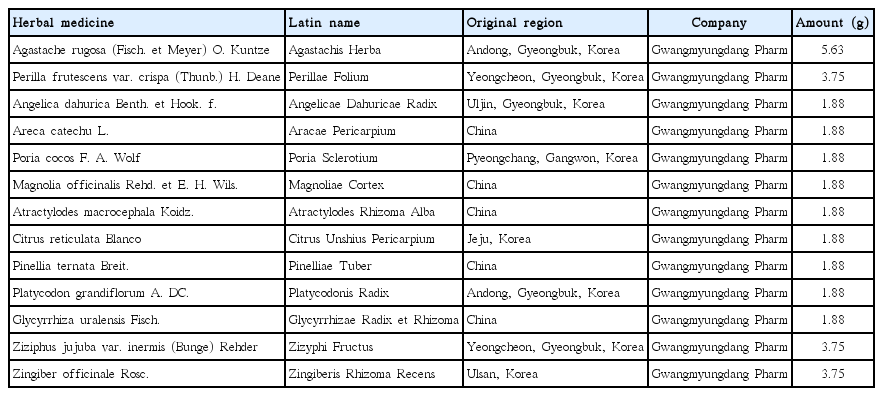Comparative Study on Biological Activities of Gwakhyangjeonggi-san Decoction According to the Preservation Periods
Article information
Abstract
Background:
Herbal formulas are generally served as a type of decoction. However, there is no scientific evidence for determining preservation and circulation period of herbal medicine decoctions. Thus, we investigated anti-inflammatory and anti-oxidative effects of the Gwakhyangjeonggi-san decoction according to its preservation period.
Methods:
Gwakhyangjeonggi-san decoction was stored for 0, 1, 2 or 3 months at room temperature. To evaluate anti-inflammatory effects, enzyme-linked immunosorbent assays (ELISAs) for tumor necrosis factor-alpha (TNF-α) and interleukin-6 (IL-6), and nitric oxide (NO) assay were conducted using the culture supernatant from RAW 264.7 cells stimulated with lipopolysaccharide (LPS). The antioxidant activities were studied by measuring free radical scavenging activities on ABTS and DPPH.
Results:
Gwakhyangjeonggi-san decoction maintained the inhibitory effects on TNF-α, IL-6 and NO productions after up to 2 months of storage in LPS-treated RAW 264.7 cells. No inflammatory response was observed in 3 months of storage. In addition, the scavenging activities on ABTS and DPPH of Gwakhyangjeonggi-san decoction were reduced time-dependently and showed less than 50% inhibition after 3 months of storage.
Conclusions:
Our results suggest that preservation period of Gwakhyangjeonggi-san decoction is recommended within 2 months after storage.
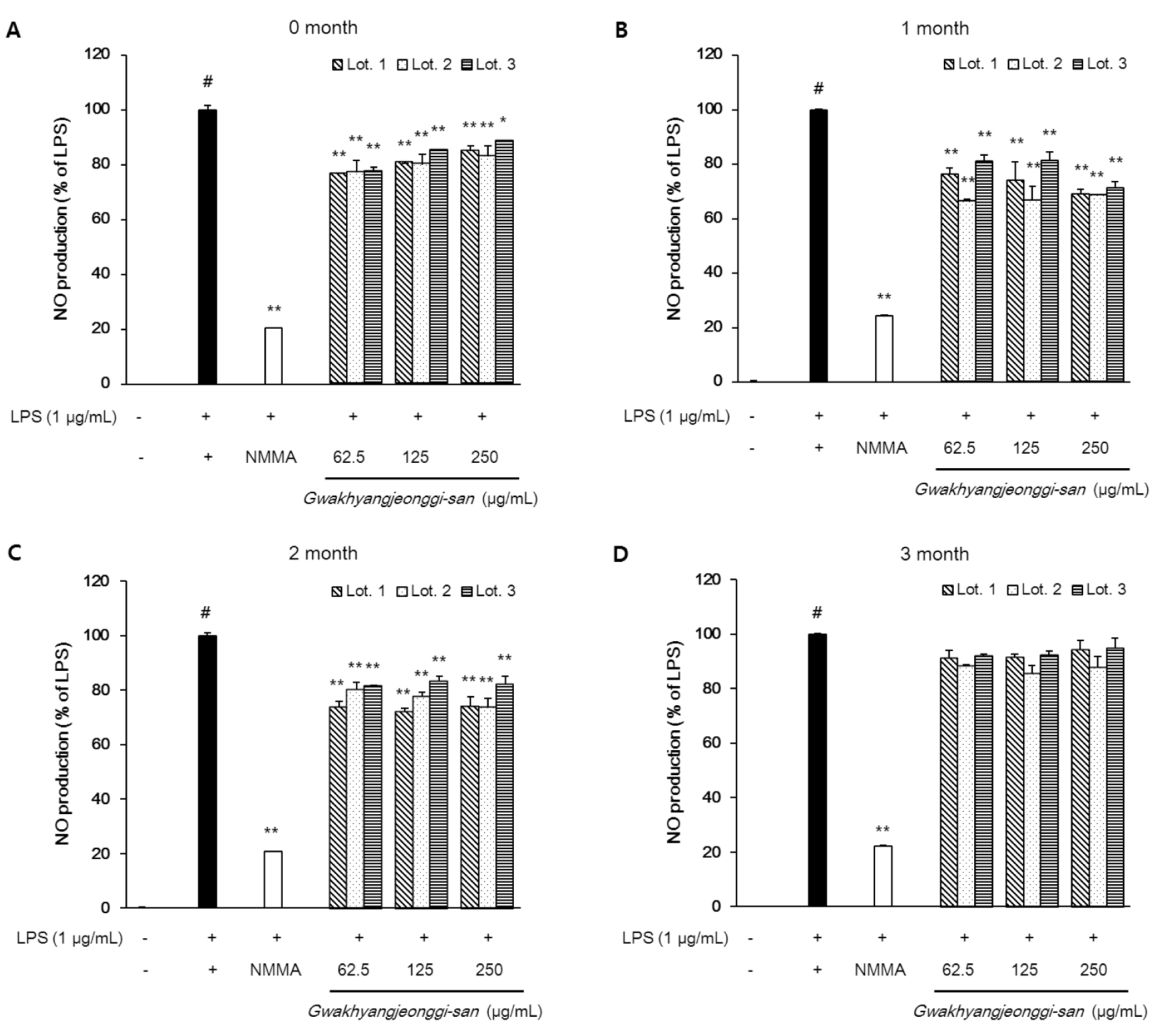
Effect of Gwakhyangjeonggi-san stored with different period on LPS-induced NO production in RAW 264.7 cells. (A) Gwakhyangjeonggi-san of 0 month storage; (B) Gwakhyangjeonggi-san of 1 month storage; (C) Gwakhyangjeonggi-san of 2 month storage; (D) Gwakhyangjeonggi-san of 3 month storage. Cells were pre-treated with Gwakhyangjeonggi-san or l-NMMA (100 M) for 4 h and then stimulated with LPS (1 g/mL) for 20 h. NO production was measured in the culture medium with the Griess reaction. The data are mean values of three experiments ± SEM (n=3). # p<0.01 versus vehicle-treated control group; * p<0.05 and ** p<0.01 versus LPS-treated cells.
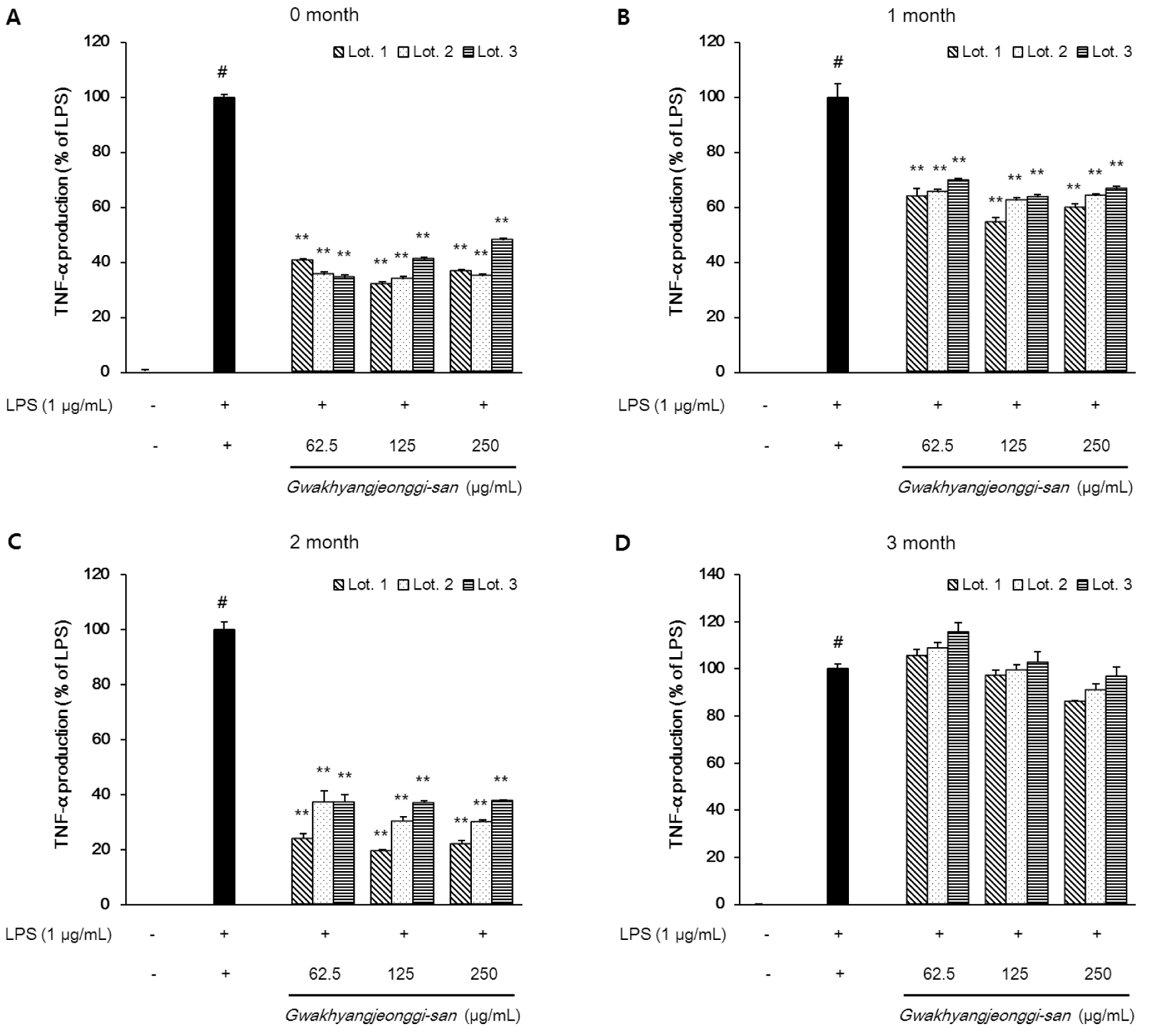
Effect of Gwakhyangjeonggi-san stored with different period on LPS-induced TNF-α production in RAW 264.7 cells. (A) Gwakhyangjeonggi-san of 0 month storage; (B) Gwakhyangjeonggi-san of 1 month storage; (C) Gwakhyangjeonggi-san of 2 month storage; (D) Gwakhyangjeonggi-san of 3 month storage. Cells were pre-treated with Gwakhyangjeonggi-san for 4 h and then stimulated with LPS (1 g/mL) for 20 h. The levels of TNF-α released into the culture medium were assessed using commercially available ELISA kit. The data are mean values of three experiments ± SEM (n=3). # p<0.01 versus vehicle-treated control group; ** p<0.01 versus LPS-treated cells.
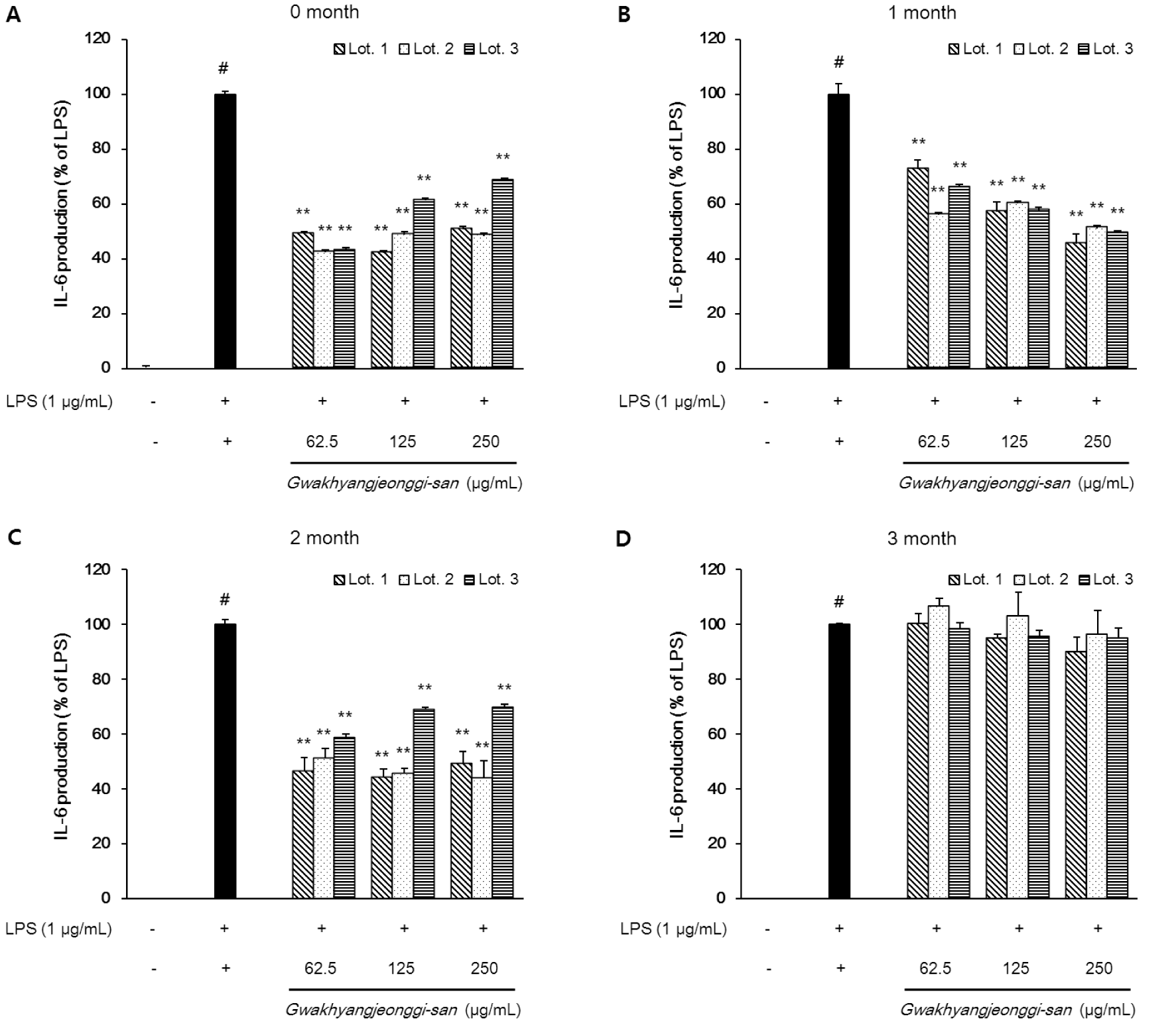
Effect of Gwakhyangjeonggi-san stored with different period on LPS-induced IL-6 production in RAW 264.7 cells. (A) Gwakhyangjeonggi-san of 0 month storage; (B) Gwakhyangjeonggi-san of 1 month storage; (C) Gwakhyangjeonggi-san of 2 month storage; (D) Gwakhyangjeonggi-san of 3 month storage. Cells were pre-treated with Gwakhyangjeonggi-san for 4 h and then stimulated with LPS (1 g/mL) for 20 h. The levels of IL-6 released into the culture medium were assessed using commercially available ELISA kit. The data are mean values of three experiments ± SEM (n=3). # p<0.01 versus vehicle-treated control group; ** p<0.01 versus LPS-treated cells.

Effect of Gwakhyangjeonggi-san stored with different period on ABTS radical scavenging activity. ABTS radical cation was produced by reacting 7 mM ABTS solution with 2.45 mM potassium persulfate store in the dark at room temperature for 16 h. Then, ABTS radical solution was added to a 96-well plate containing of samples or ascorbic acid (AA, 5 g/mL). After 30 min of incubation, the absorbance was measured at 743 nm using a microplate reader. The data are mean values of three experiments ± SEM (n=3). * p<0.1, ** p<0.01 versus 0 month.
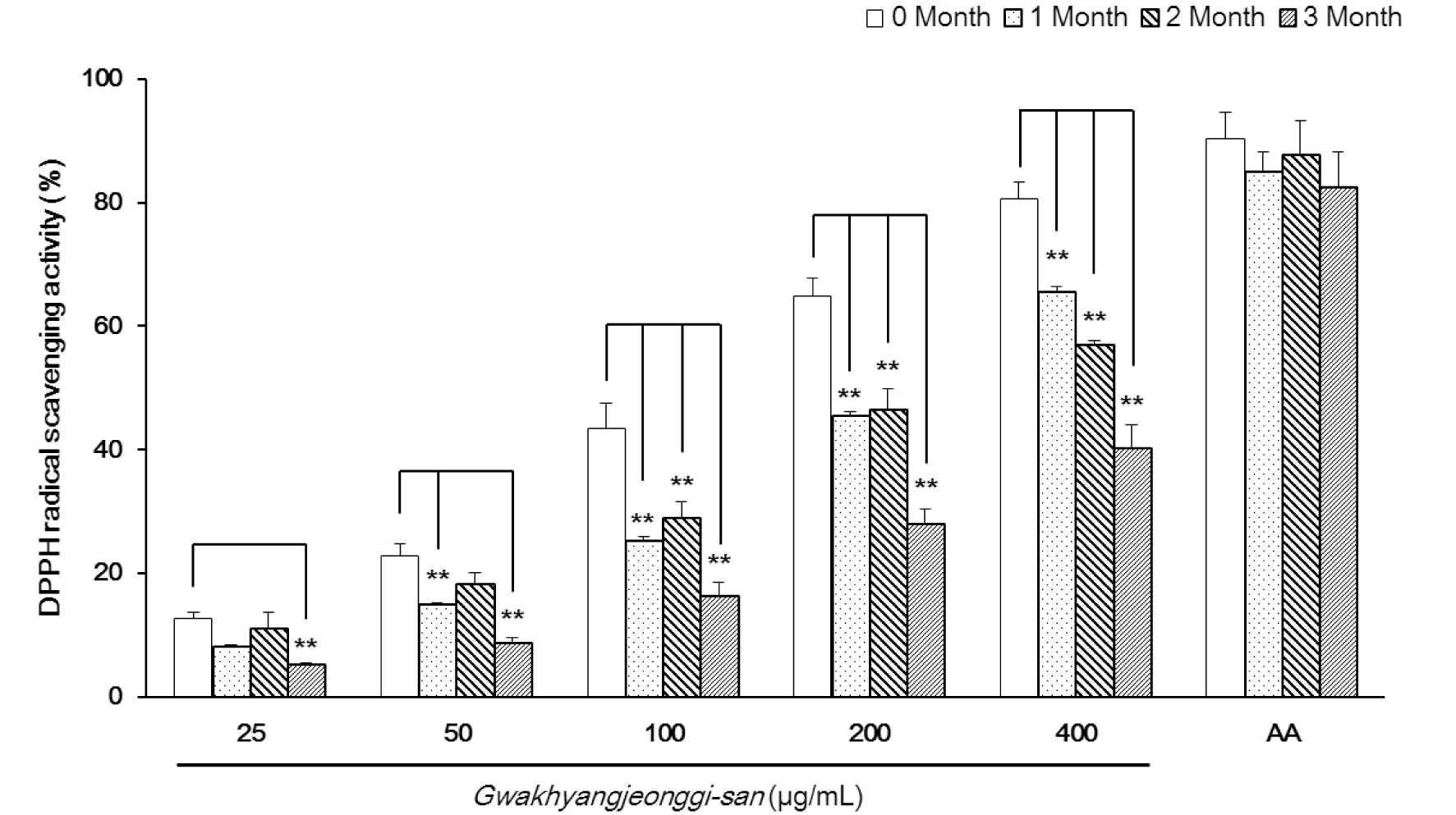
Effect of Gwakhyangjeonggi-san stored with different period on DPPH radical scavenging activity. DPPH radical solution (0.15 mM in ethanol) was added to a 96-well plate containing of samples or ascorbic acid (AA, 20 g/mL). After 30 min of incubation, the absorbance was measured at 517 nm using a microplate reader. The data are mean values of three experiments ± SEM (n=3). ** p<0.01 versus 0 month.
